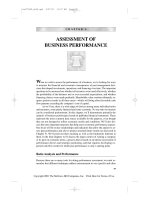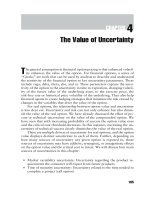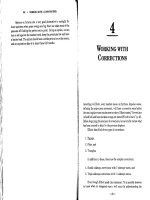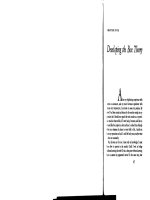Chapter 4 revenue
Bạn đang xem bản rút gọn của tài liệu. Xem và tải ngay bản đầy đủ của tài liệu tại đây (133.99 KB, 26 trang )
OPEN UNIVERSITY HCMC
MBA PREPARATORY COURSE
Principles of
Financial Accounting
Chapter 4
Accounting for Sales
Learning Objectives
After studying this chapter, you should
be able to:
Recognize revenue items at the proper
time on the income statement.
Account for cash and credit sales.
Record sales returns and allowances, sales
discounts, and bank credit card sales.
Manage cash and explain its importance to
the company.
Learning Objectives
After studying this chapter, you should
be able to:
Estimate and interpret uncollectible
accounts and receivable balances.
Assess the level of accounts receivable.
Develop and explain internal control
procedures.
Recognition of Revenue
The timing of revenue recognition is
critical to the measurement of net income.
• Revenue is part of the calculation of net
income.
Net income = Revenue - Expenses
• Measurement of revenue sometimes
determines when a company recognizes
certain expenses because of the matching
principle.
Expenses must be recognized in the same
period as the revenues that create the
expenses.
Recognition of Revenue
Some users of financial information want
revenues to be recorded as soon as
possible.
Others want to be sure that a company
will actually receive payment before
revenues are recorded.
Accountants must carefully assess when
revenue should be recognized.
Recognition of Revenue
Recognition of revenue requires a
two-pronged test:
• The revenue is earned.
Goods or services must be delivered to the
customers.
• The revenue is realized.
Cash or other assets must received.
Recognition of Revenue
Most revenues are recognized at the point of
sale (when goods are sold and cash changes
hands).
• At this point, both recognition tests are met.
Sometimes the tests are not always met at the
same time. This results in unearned revenue.
• Cash is received, but nothing is given in
exchange.
Recognition of Revenue
What happens if revenue on one “sale” is earned
over a long period of time, for example, on a
long-term contract?
Generally, the revenue from a long-term contract
should be recognized as the work on that
contract is performed.
• For example, if one-fourth of the work is
completed in the first year, one-fourth of the
revenue should be recognized.
Measurement of Revenue
Revenue is measured in terms of the
cash equivalent value of the asset
received.
Journal entries to record sales:
Cash
Sales revenue
1,000
Accounts receivable
Sales revenue
1,000
1,000
OR
1,000
Merchandise Returns
and Allowances
What happens when sales are recognized
at the point of sale and a customer returns
the goods that were sold?
Sales returns - products returned to the
seller by the purchaser for various reasons
• These are purchase returns from the
customer’s perspective.
Merchandise Returns
and Allowances
Sometimes, instead of returning
merchandise, the customer demands a
reduction, (a sales allowance) in the
selling price.
Sales allowance - reduction of the original
selling price, which is the price previously
agreed upon by both parties
• These are purchase allowances from the
customer’s perspective.
Merchandise Returns
and Allowances
Usually, a contra account called Sales Returns
and Allowances is used to accumulate both sales
returns and sales allowances.
• By using a contra account, the amount of gross
sales is readily available, which allows
managers to monitor the level of returns and
allowances for various reasons.
• Using the contra account avoids changing the
original sales entry for the amounts returned.
Merchandise Returns
and Allowances
Journal entries for returns and
allowances:
To record the sale:
Accounts receivable
Sales revenue
900
900
To record the returns and allowances:
Sales returns and allowances
Accounts receivable
200
200
Merchandise Returns
and Allowances
Gross sales - total sales revenue before deducting
sales returns and allowances, if any
Net sales - total sales revenue reduced by sales
returns and allowances
Income statement presentation:
Gross sales
Less: Sales returns and allowances
Net sales
====================
$900,000
80,000
$820,000
Merchandise Returns
and Allowances
Discounts on sales also affect the
amount reported as sales.
Two major types of discounts:
• Trade discounts
• Cash discounts
Merchandise Returns
and Allowances
Trade discounts - reductions to the gross
selling price for a particular class of
customers to arrive at the actual selling
price (invoice price)
• Trade discounts are generally price
concessions or purchase incentives.
The gross sales revenue recognized from a
trade discount is the price received after
deducting the discount.
Merchandise Returns
and Allowances
Cash discounts - reductions of invoice
prices awarded for prompt payment of the
invoice
• Encourage prompt payment and reduce
manufacturer’s or seller’s need for cash
• Reduces the risk of bad debts
(nonpayment)
Purchasers should always take purchase
discounts if possible.
Accounting for
Net Sales Revenue
Cash discounts and sales returns
and allowances are recorded as
deductions from gross sales.
Gross sales
$20,000
Deduct:
Sales returns and allowances $200
Cash discounts on sales
550
750
Net sales
$19,250
Accounting for
Net Sales Revenue
The income statement allows
different systems for accounting for
net sales.
• The preceding example shows sales,
sales returns and allowances, and cash
discounts in separate accounts.
• Net sales can be shown in one account
where all sales returns and allowances
and cash discounts directly decrease the
sales account.
Cash
Many companies combine cash and
cash equivalents on their balance
sheets.
• Cash equivalents - highly liquid shortterm investments that can easily and
quickly be converted into cash
Cash encompasses all items that
are accepted for deposit
by a bank.
• Paper money, coins, money orders,
and checks
Credit Sales and
Accounts Receivable
Accounts receivable - amounts owed to a
company by customers as a result of
delivering goods or services and extending
credit in the ordinary course of business
• Also known as trade receivables or
simply receivables
• The main benefit of granting credit is a
boost in sales and profits that would
otherwise be lost if credit were not
extended.
Assessing the Level of
Accounts Receivable
Management should monitor the
ability of the company to control
accounts receivable.
• They often use accounts receivable
turnover for measuring that ability.
Credit sales
A/R turnover =
Average accounts receivable
Assessing the Level of
Accounts Receivable
Accounts receivable turnover indicates
how rapidly collections of accounts
receivable occur.
• The ratio tells how many times, on
average, accounts receivable “turn over”
during the year.
• Higher turnovers indicate that
receivables are collected quickly.
• Lower turnovers indicate that
receivables are collected more slowly.
Assessing the Level of
Accounts Receivable
Days to accounts receivable (average
collection period) - an indication of
how long it takes to collect money
after a sale is made
365 days
Days to collect A/R =
A/R turnover









